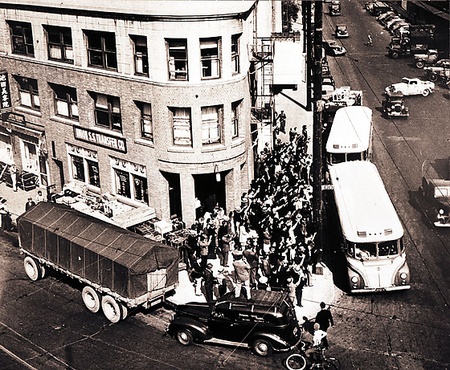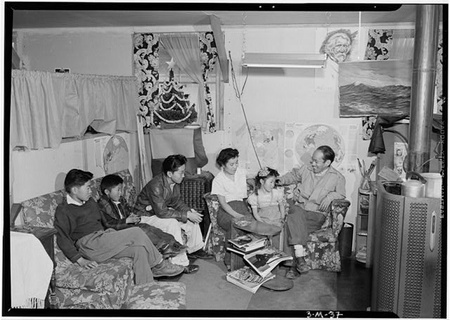Read Part 13 >>
Back to Japan, 1933-1936
When Miyatake’s father fell ill in Japan in 1933, Toyo was selected to represent the family and returned to Japan to pay his respects. By the time he and his family had completed the two-week passage, however, Toyo’s father had died. As the de facto head of the family (his older brother, who traditionally would have filled this role, was in Los Angeles running the confectionary shop), Miyatake felt bound to stay on in Japan. Yet he felt ill at ease on tradition-bound, provincial, Shikoku Island. Miyatake considered opening a photography studio in Tokyo, but his friends discouraged him, believing that Tokyo was not yet ready for the daring, modernist art photography that was his forte.
Convinced he could not work as he wished in Japan, Miyatake returned to Los Angeles after a year, leaving Archie and his brother Robert there to continue their Japanese education with Hiroko caring for them. Perhaps missing his wife’s savvy business mind to oversee studio finances, Miyatake pursued the more manageable work of retouching negatives for the photography studio at Bullock’s department store. Two years later, in 1936, Hiroko and her sons, concerned about Toyo’s welfare, returned to America. Archie and his brother had become Kibei, Americans of Japanese descent who studied in Japan before returning to the United States.
Miyatake became a well-known figure around Little Tokyo as the owner of his own photography studio and the professional community members called when there was an occasion to commemorate. “In the prewar era, no social event, family or wedding portrait or funeral photograph was official unless taken by Toyo Miyatake,” my uncle wrote in his memoir. “His photographs were the ‘hallmark’ of excellence.”

Miytake was pre-war Little Tokyo's photographer of record, immortalizing events such as the 10th anniversary gathering of the North American Young Women's Buddhist Association in 1936. Photograph by Toyo Miyatake. (Source: Buddhist Churches of America Archives collection, Japanese American National Museum. [99.201.32])
As his reputation grew, Miyatake and his wife Hiroko also became tireless hosts and portrait photographers to a stream of Japanese dignitaries, from film stars to athletes. “The portrait file in his studio is in itself a history of cultural exchange between the United States and Japan,” wrote the Japanese photographer and editor Eikoh Hosoe; Miyatake played the role of a “private consular representative, taking care of the Japanese who visited the United States.”
Although Miyatake continued to pursue art photography throughout his life, the financial demands involved in raising a family inevitably steered his work toward more conventional portrait photography.
Evacuated
When the Japanese bombed Pearl Harbor in December 1941, the Miyatake family’s only choice was to be evacuated or to leave the West Coast, perhaps for Chicago, New York, or Salt Lake City, as some Japanese did. Miyatake, then 47, chose to stay, and was forced to shutter his Little Tokyo photo studio. He requested that his family be interned with the Little Tokyo residents he felt most kinship with rather than his East Los Angeles neighbors.

Bird's eye view of the Nishi Hongwanji Buddhist Temple (now home to the Japanese American National Museum) during the 1942 forced removal of Japanese Americans. Photograph by Jack Iwata. (Gift of Jack and Peggy Iwata, Japanese American National Museum [93.102.102])
For the duration of his imprisonment, Miyatake’s business dealings outside the Japanese immigrant community served him well. His longstanding role as photographer for the graduating class of White Memorial Hospital, located near his home, made its rental to a series of residents from the hospital an easy deal to negotiate. Miyatake put all of his photographic equipment in storage and the family walked out of its home with only a few personal items, fairly sure that its tenants would pay the $25 monthly mortgage. Although many internees returned home to find they had lost their land and belongings, the Miyatakes did not.
They departed for Manzanar on April 26, 1942, two days before my father and his family left for the same concentration camp. Archie recalled playing outdoors at Manzanar with some friends three or four months after his arrival when his father called him inside their barrack. He wanted to show his son a camera lens, some film holders and ground glass — the essential components of a camera, a banned article under proclamations issued by the military’s Western Defense Command — that he had smuggled in to the camp.
Archie remembered his father, speaking in Japanese, saying, “As a photographer I have the responsibility of recording everything that happens in this camp, to keep a record so this kind of thing will never happen again.”
Miyatake asked an auto mechanic friend in the prison camp to make a wooden box to fit the focal length of the lens and the size of the viewing screen. His friend fashioned a box out of a combination of scrap ash, mahogany and wood cut from the locust trees dotting the grounds of the concentration camp. He then fitted one side of the box with a two-inch drain pipe to which Miyatake attached his lens. “My father showed me how he could focus the lens by turning it on the drain pipe,” Archie recalled. Miyatake completed his makeshift camera by affixing a 4" x 5" sheet film holder to the back of the box.

Toyo Miyatake and his family at Manzanar. Photograph by Ansel Adams. (Source: Library of Congress Prints and Photographs Division Washington, D.C. 20540 USA)
© 2011 Nancy Matsumoto





